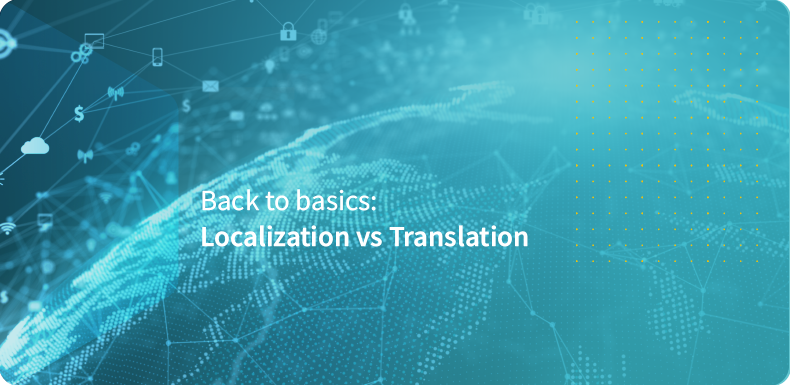It has occurred to each of us. You’ve landed on a website that doesn’t use your native language. It displays information in various currencies, and images may fall short of your expectations. Overall, you have the impression that you are in an unfamiliar environment.
When potential clients visit your site, you don’t want them to feel the same way. If you’re a businessman, paying for localization is essential if you don’t want them to have such an experience.

In this article, we will shed some light on the concepts of localization and translation, and get clarity on the fundamental distinction between the two processes.
Spend some time talking to people outside the localization industry, and you’ll notice that the terms “localization” and “translation” are frequently used interchangeably.
Localization and translation are frequently used interchangeably, but they refer to two distinct processes (one being an aspect of the other). According to the Globalization and Localization Association, translation adapts a message, whereas localization adapts an experience.
What is Localization?
Localization is a method of adapting goods and services to specific locations and communities. It is the process of adapting your website, mobile app, software, video game, multimedia content, and voice-over to the most appropriate and acceptable version for a specific local audience.
Depending on the service you provide, you can use a variety of localization methods and techniques. A single localization job for a software firm could include services ranging from software localization (customizing a software’s user interface for a new audience) and written text localization (customizing the copy on a product page for a specific language) to initiatives such as mobile app localization.
The primary goal of localization is to give your product, offering, service, or even just your text the appearance and feel of one designed specifically for your target market, regardless of their native language, customs, or religion.
Localization also entails tailoring extra features to a particular market, such as:
- Modifying graphics and design to properly display translated text.
- Transforming data to meet certain specifications.
- Using local measurement units and currencies.
- Using appropriate formatting for a date, address, and phone number components.
- Adhering to local laws and regulations
In a nutshell, localization gives a product the look and feel that the intended audience expects, with the primary goal of giving your content the appearance of being created specifically for your new target market.
What is Translation?
Translation, on the other hand, simply refers to the conversion of written or spoken content from the source language into the target language while adhering to grammar and syntax rules. It is not a word-for-word translation, but rather a complex process that takes into account the standards and guidelines of each language.
Translation is required because, among other things, it is the stage of the localization process in which you must rewrite user manuals, medical documents, technical publications, manuals, scientific journals, and literature. And the translators are required to produce accurate work to ensure that the message in the target language keeps the original meaning of the source text.
Difference between localization and translation
Translation transforms text at its core, whereas localization transforms the entire product or content from one language to another. Localization has no bounds, and it goes far beyond translation.
Although translation is a component of localization, much more is required for content to become authentic and locally accepted.
Here’s a summary of the differences between the two processes, with examples, and where their applications are most appropriate:
![]() When localizing symbolic meanings of visuals such as images, videos, colors, emojis, and so on, the content is created with the customs, beliefs, and traditions of the target audience in mind (e.g., you should never use images of bacon when localizing for countries where pork is taboo based on the Islamic legal system). Translation, on the other hand, can be used to fully convert numeric differences such as currency, units of measure, date, and time formats.
When localizing symbolic meanings of visuals such as images, videos, colors, emojis, and so on, the content is created with the customs, beliefs, and traditions of the target audience in mind (e.g., you should never use images of bacon when localizing for countries where pork is taboo based on the Islamic legal system). Translation, on the other hand, can be used to fully convert numeric differences such as currency, units of measure, date, and time formats.
![]() Localization is recommended for language-specific content such as dialects, idioms, slang, and tone for the best possible outcome in the intended market. In contrast, translation alone would suffice in the conversion of legal requirements involving compliance with the General Data Protection Regulation (GDPR) or Strong Customer Authentication (SCA) in Europe.
Localization is recommended for language-specific content such as dialects, idioms, slang, and tone for the best possible outcome in the intended market. In contrast, translation alone would suffice in the conversion of legal requirements involving compliance with the General Data Protection Regulation (GDPR) or Strong Customer Authentication (SCA) in Europe.
![]() Text length: conversion of content from English to other languages take twice as long. As a result, different wordings may be required to fit the text into your design while still conveying the same message. This mainly applies to translation, though instructions may be passed to the localization manager in this regard. Cultural preferences, on the other hand, are strictly for the localization manager to consider. Checks, for example, are widely accepted as a payment method in the United States of America but are rarely used in Europe.
Text length: conversion of content from English to other languages take twice as long. As a result, different wordings may be required to fit the text into your design while still conveying the same message. This mainly applies to translation, though instructions may be passed to the localization manager in this regard. Cultural preferences, on the other hand, are strictly for the localization manager to consider. Checks, for example, are widely accepted as a payment method in the United States of America but are rarely used in Europe.
![]() Right-to-left writing, which is used in many Semitic languages such as Arabic and Hebrew. You may want to change the layout of your website, including the placement of the menu, for this (this will be a procedure based on localization). Whereas user data fields are for the translator to keep an observant eye on, for instance, when filling out address data fields, US customers must enter the state, whereas UK customers may enter the county.
Right-to-left writing, which is used in many Semitic languages such as Arabic and Hebrew. You may want to change the layout of your website, including the placement of the menu, for this (this will be a procedure based on localization). Whereas user data fields are for the translator to keep an observant eye on, for instance, when filling out address data fields, US customers must enter the state, whereas UK customers may enter the county.
There are significant differences between localization and translation. Both tools can be beneficial to your business in different ways. However, it is important to understand what works best in which context. This will help you to convey your message without shooting yourself in the foot.
Who Needs Localization?
Localization makes content more appealing, which increases the likelihood of purchase. According to a 2014 Common Sense Advisory report, 75%of consumers said they were more likely to purchase goods and services if the corresponding product information was in their native language.
By that logic, anyone attempting to reach a global audience should consider both localization and translation as part of their expansion strategy.

Conclusion
Localization and research-based translation are fascinating because, when done well, you don’t even notice them. Localization gives you the impression that a program, website, or mobile application was created specifically for you, rather than as a generic, one-size-fits-all experience.
In the end, the most important factor in determining whether your localization project is successful is the skill of the team who works on your materials. When delivering fully localized materials, the audience should not be able to tell that the content they are reading or the product they are holding has been translated from another language.
It should be impossible to tell that your product or content was created in English, for example, and then localized into the consumer’s native language. A properly localized product should appear and feel as if it was designed specifically for the target market.
Sinapi has the expertise and technology to handle any type or size of a localization project, from websites or software conversion to technical documentation, multimedia, training and e-learning, and marketing materials. Should you require our assistance on any of these services, reach out to us and communication would be established by one of our care staff.




